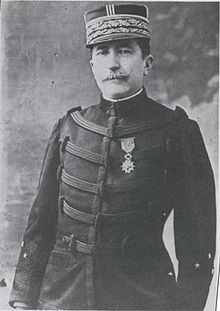Georges Picquart
| Marie Georges Picquart | |
|---|---|
 Georges Picquart in the uniform of General of Division | |
| Born |
6 September 1854 Strasbourg, France |
| Died |
19 January 1914 (aged 59) Amiens, France |
| Place of burial |
Père Lachaise Cemetery Paris, France |
| Allegiance | France |
| Service/branch | French Army |
| Years of service | 1872–1902, 1906–1914 |
| Rank | Général de division |
| Commands held | 2e Corps d'Armée |
| Other work | Minister of War (1906–1909) |
Marie Georges Picquart (Strasbourg, 6 September 1854 – Amiens, 19 January 1914), was a French army officer and Minister of War. He is best known for his role in the Dreyfus Affair.
Early career
Major Picquart began his military career in 1872, graduating from the Ecole Spéciale Militaire de Saint-Cyr as fifth in his year. Picquart served as an infantry officer in France before seeing service in Indochina. He subsequently studied at the General Staff Academy (l'école d'État-major) where he was second in his class, before becoming a lecturer at the War Academy (l'École supérieure de guerre). One of his students at the latter institute was Alfred Dreyfus.
Picquart and the Dreyfus Affair
Picquart was then appointed to the General Staff in Paris. As a staff officer he acted as reporter of the debates in the first Dreyfus court martial for the then Minister of War and the Chief of the General Staff. Picquart was subsequently promoted to the rank of lieutenant-colonel on 6 April 1896. He was appointed chief of the army's intelligence section (Deuxième Bureau, service de renseignement militaire) in 1895. The following year Picquart discovered that that the memorandum (bordereau) used to convict Captain Alfred Dreyfus, had actually been the work of Major Ferdinand Walsin Esterhazy. Several high-ranking generals warned Colonel Picquart to conceal his discovery but Picquart persisted and continued his investigation. In this he was hindered and sabotaged by subordinate officers, notably Major Henry. As a consequence Picquart was relieved of duty with the Deuxième Bureau and sent (December 1896) to regimental duty, commanding the 4th Regiment of Tirailleurs (native infantry) in French Tunisia.
After the trial of Émile Zola, Picquart was himself accused of forging the note that had convinced him of Esterhazy's guilt. He was then arrested for forgery and was waiting for a court martial during the period that the French Supreme Court was reviewing the Dreyfus case. After the second court-martial – held as a consequence of the conclusions of the Supreme Court – Picquart resigned from the army. However the exoneration of Alfred Dreyfus in 1906 also absolved Picquart, who was, by an act of the Chamber of Deputies, promoted to brigadier-general. This was the rank that an officer of his seniority and experience could normally have expected to reach, had his career not been interrupted by involvement in the Dreyfus affair.[1]
Subsequent career
In 1906 General Picquart entered Georges Clemenceau's first cabinet as Minister of War. He held that position for the entire duration of the Clemenceau Cabinet, from 25 October 1906 to 24 July 1909. Picquart then returned to military service as an Army Corps commander.
Private life
A keen amateur pianist, Picquart was a regular visitor to the Chaigneau family, whose daughters formed the Trio Chaigneau. He later helped arrange concerts for them.[2]
Death
While still a serving army officer, Picquart died on 19 January 1914 from injuries received in a fall from a horse.
See also
- List of War Ministers of France
- Dreyfus affair
- "Picquart", a poem by Florence Earle Coates
References
In Fiction
- An Officer and a Spy (2013), by Robert Harris, a novel about the Dreyfus Affair written from the point of view of Georges Picquart.
External links
- Dreyfus Rehabilitated
- Official Website of Geudertheim with page about Général Picquart (in French).
| Political offices | ||
|---|---|---|
| Preceded by Eugène Étienne |
Minister of War 1906–1909 |
Succeeded by Jean Brun |
|